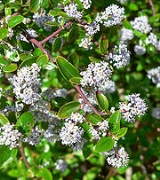
Ceanothus oliganthus
Encyclopedia
Ceanothus oliganthus is a species of shrub
in the buckthorn family Rhamnaceae
known by the common name Hairy ceanothus. It is endemic to California
, where it can be found in most of the coastal mountain ranges in dry habitat such as chaparral
.
is a cluster or series of clusters of blue or purple flowers. The fruit is a capsule which may be hairy or not, depending on variety. The variety of this species known as jimbrush (var. sorediatus) is sometimes treated as a separate species.
Shrub
A shrub or bush is distinguished from a tree by its multiple stems and shorter height, usually under 5–6 m tall. A large number of plants may become either shrubs or trees, depending on the growing conditions they experience...
in the buckthorn family Rhamnaceae
Rhamnaceae
Rhamnaceae, the Buckthorn family, is a large family of flowering plants, mostly trees, shrubs and some vines.The family contains 50-60 genera and approximately 870-900 species. The Rhamnaceae have a worldwide distribution, but are more common in the subtropical and tropical regions...
known by the common name Hairy ceanothus. It is endemic to California
California
California is a state located on the West Coast of the United States. It is by far the most populous U.S. state, and the third-largest by land area...
, where it can be found in most of the coastal mountain ranges in dry habitat such as chaparral
Chaparral
Chaparral is a shrubland or heathland plant community found primarily in the U.S. state of California and in the northern portion of the Baja California peninsula, Mexico...
.
Description
This is a large, erect shrub approaching 3 meters in maximum height. The evergreen leaves are alternately arranged and may be up to 4 centimeters long. They are dark green on top, paler and hairy on the underside, and are edged with glandular teeth. The inflorescenceInflorescence
An inflorescence is a group or cluster of flowers arranged on a stem that is composed of a main branch or a complicated arrangement of branches. Strictly, it is the part of the shoot of seed plants where flowers are formed and which is accordingly modified...
is a cluster or series of clusters of blue or purple flowers. The fruit is a capsule which may be hairy or not, depending on variety. The variety of this species known as jimbrush (var. sorediatus) is sometimes treated as a separate species.

